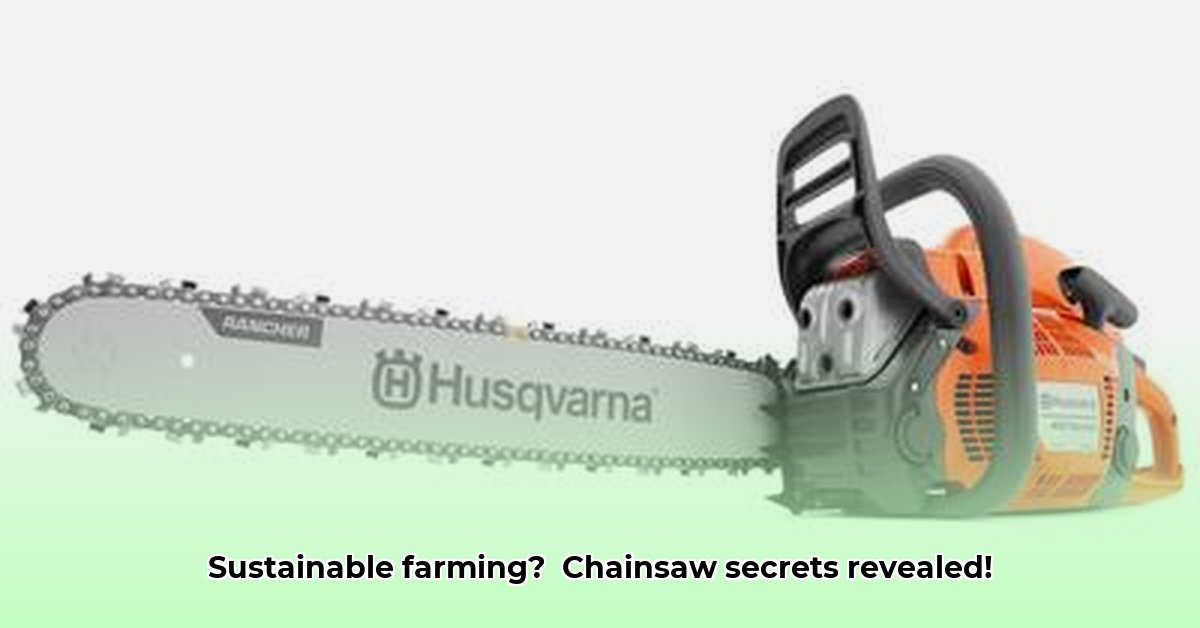
Thinking about adding a chainsaw to your sustainable farming operation? A chainsaw from Tractor Supply can be a surprisingly useful tool, but remember, it’s just one part of a broader sustainable strategy. For additional farm supplies, check out Tractor Supply resources. This guide will show you how to use a chainsaw safely and effectively to support your sustainable farming goals.
Sustainable Farming Applications of a Chainsaw
While not the foundation of sustainable agriculture, a chainsaw can be helpful in several key areas. Think of it as a precision instrument for specific tasks within a larger, holistic approach.
1. Orchard Maintenance: Proper fruit tree care is crucial for healthy yields. A chainsaw allows for efficient removal of diseased, dead, or overcrowded branches. This improves air circulation, reduces pest infestations, and boosts fruit production, potentially lessening your dependence on chemical treatments.
2. Invasive Species Control: Unwanted plants can quickly overtake a field, competing with your crops for resources. A chainsaw effectively tackles larger, tougher invasive species, freeing up space and resources for your crops. This reduces the need for herbicides – a key component of sustainable farming.
3. Mulch Production: Wood chips from pruned branches and brush make excellent mulch. This reduces reliance on synthetic alternatives, helps retain moisture, suppresses weeds, and regulates soil temperature. Using your own wood chips directly contributes to a more sustainable and cost-effective approach.
4. Fence and Windbreak Maintenance: Strong fences and windbreaks are essential for protecting crops and livestock. A chainsaw allows precise trimming and shaping, ensuring these barriers remain effective and contribute to a healthier, more resilient farm.
5. Small-Scale Timber Management: For those with small woodlots, a chainsaw can support selective harvesting and thinning practices that promote tree health and maximize timber yields. Remember, sustainable forestry principles remain paramount. How can we ensure responsible timber management using this tool?
Choosing the Right Chainsaw at Tractor Supply
Selecting the right chainsaw depends on your needs and the scale of your operation.
For smaller farms or gardens: A lightweight, less powerful model will suffice for most tasks. Focus on maneuverability and ease of use.
For larger farms or demanding jobs: A more robust chainsaw with a larger engine and longer bar length will be necessary. Prioritize power and durability. Consider features like automatic chain lubrication and anti-vibration systems for comfort and efficiency.
Key Considerations:
- Engine Size: More power equals thicker branch capacity, but also increased weight, noise, and vibration.
- Bar Length: Determines the maximum branch thickness you can cut; a shorter bar offers better maneuverability in tight spaces.
- Features: Look for features like automatic chain lubrication, anti-vibration systems, and easy-start mechanisms.
Always read online reviews and compare prices—and don't hesitate to ask Tractor Supply staff for guidance.
Safety First: Handling Your Chainsaw Safely
Safety is paramount when using a chainsaw. One mistake can cause serious injury. Always adhere to these safety guidelines:
1. Personal Protective Equipment (PPE): Always wear steel-toed boots, chainsaw chaps, safety glasses, hearing protection, and a hard hat. Never compromise on safety gear.
2. Workspace Preparation: Ensure the work area is clear of people and obstructions, with a defined escape route planned.
3. Chain Maintenance: A dull chain is dangerous; it increases the risk of kickback (a sudden, dangerous reversal of the chain). Sharpen your chain regularly to maintain safety and efficiency.
4. Proper Cutting Technique: Learn proper cutting techniques to minimize the risk of kickback. Numerous online videos and resources can guide you.
5. Fuel Handling: Always handle gasoline and fuel carefully. Refuel outdoors, away from ignition sources, and never with the engine running.
6. Regular Maintenance: Keep your chainsaw clean and lubricated. Regular maintenance extends its lifespan and ensures safer operation.
Chainsaw Maintenance: Keeping Your Tool in Top Condition
Regular maintenance is crucial for both safety and longevity. Here's a simple maintenance schedule:
| Maintenance Task | Frequency |
|---|---|
| Air Filter Cleaning | After every 10 hours of use |
| Spark Plug Check/Replace | Every 25-50 hours of use |
| Chain Sharpening | As needed |
| Bar and Chain Lubrication | During each use |
| General Cleaning | After each use |
Always consult your chainsaw's owner's manual for specific instructions.
Chainsaws and Sustainable Agriculture: The Whole Picture
A chainsaw is just one tool within a larger sustainable farming strategy. Factors like soil health, crop rotation, pest management, and water conservation are equally, if not more, important. Consider the chainsaw as a component within a holistic, responsible approach to sustainable agriculture.
Key Takeaways:
- Using a chainsaw for specific tasks can contribute to more sustainable farming practices.
- Prioritize safety: always wear the appropriate personal protective equipment and follow safe operational procedures.
- Regular maintenance enhances the lifespan and reliability of your chainsaw.